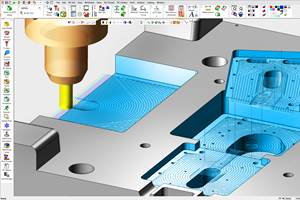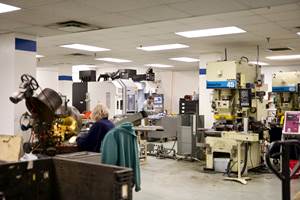“Come back tomorrow and we will show you.”
That was the invitation from an enterprising mold shop owner in Japan to Doug Noxell, who expressed some disbelief at what he was seeing. He had just looked at the core side of a mold for an automotive grill. This part of the mold was in the final stages of preparation for assembly. Ejector pins, slides and lifters were being installed as he watched. The cavity side of this rather large mold was still on the bed of the machining center, but none of the 3D milling had started. It was set to begin that morning, yet test shots of the finished mold were scheduled for the following afternoon.
“No way can they finish and spot this mold in that amount of time,” Mr. Noxell thought to himself. He asked the translator to verify the invitation.
“Oh, yes. They will be ready,” was the response. When Mr. Noxell returned the next afternoon, the mold was indeed in the injection press on time—and making good parts. By machining the cavity the rest of the previous day and overnight, the 3D milling was done on time. By leaving no excess stock in the process, the mold could be completed with virtually no hand work and with only a few minutes in the spotting press.
Mr. Noxell learned that, in fact, both sides of the mold had been machined to precisely 0.0004 inch less than the CAD model. This “negative stock condition” was the secret that allowed the mold to be completed and tested is such remarkably short time.
That was back in 1999. Mr. Noxell was in Japan to learn more about the CAM software he had seen a few months earlier at a machine tool show in Chicago. The software, CAM-Tool, originated at CGS North America, Inc., a software developer based in Tokyo. In his 20-plus years in mold making, he had never seen software like this. Demos showed the software programming tool paths that could do high speed milling so well that resulting surfaces needed no polishing. Geometry of finished parts matched the CAD model to within millionths of an inch. The usual deviations produced by processing error were gone.
On his trip to Japan, Mr. Noxell toured several mold shops where he could observed the machining techniques that these shops were adopting, largely because the programming software allowed them to take advantage of the improved accuracy of machine tools.
When Mr. Noxell returned, he set up CGS North America in Oldcastle (Windsor), Ontario, to distribute this software in the United States and Canada. Along with marketing the software, he devoted considerable time to promoting this new approach to machining mold surfaces. The concept of eliminating excess stock and even removing an extra 0.0004 to 0.0008 inch from the surfaces was difficult for most shops to accept.
Mr. Noxell wanted to show them that cutting to negative stock had many benefits. The slight gap between shutoff surfaces would keep edges at parting lines from contacting, thus reducing wear, yet not allow most plastics to flash. The gap also would also allow air to escape from the mold as it closed, thus creating more even venting and better flow of the plastic.
Realizing that he needed to do convincing test cuts and live machining demos, he and his partner, Joe Copot, created a shop that would focus just on high-accuracy, semi-finish and finish machining of 3D geometry in molds. The shop, SurKut Machining Technology, is located in Tecumseh, Ontario, also near Windsor.
Soon after, it became clear that Mr. Noxell would have to choose between being a software seller and a machining service provider. Although he continues to promote the software as a high speed machining consultant and advisor, he chose to practice what he’d been preaching about high speed milling and cutting to negative stock.
No Weak Links, No Half Measures
One of the lessons that he emphasized, as might be expected, is the importance of CAM software as a key component of the machining-to-zero concept.
“My years of experience with machining hardened material to extremely tight tolerances taught me that it is all about managing the variables to minimize errors,” Mr. Noxell says. As he explains, not being able to control these variables adequately with conventional programming, tooling and machining techniques is the reason why shops routinely left 0.001 to 0.003 inch of stock on 3D mold surfaces and shutoff areas. Shops could compensate for errors that stacked up in the process by leaving excess stock as a safety margin.
One source of error can be the CNC tool path. Mr. Noxell knew that all tool paths are not created equally. Some are more accurate than others, and the extreme accuracy of CAM-Tool caught his attention. Likewise, not all tool paths are equally suitable for high speed machining or for use with very small cutting tools. How the cutter approaches the material and moves across its surface determines the quality of the finish and the life of the tool. The software was exceptional in this regard as well.
However, a good tool path is only part of the picture. Other sources of error need to be addressed. Every element of the machining process must be engineered to minimize error and avoid vibration.
This is reflected in SurKut’s choice of machining resources. The shop has a Johnford DMC-1600HN and a Topper NV812. The first machine has a work envelope of 63 by 51 by 32 inches in X, Y and Z; the second of 47 by 31 by 20 inches.
“Both of these machines feature bridge-type construction, and that is no accident,” Mr. Noxell says. This configuration minimizes overhang of the column above the bed. The opposing columns in the bridge stabilize machining forces and make the machines more rigid than the typical C-frame design. Both machines were sourced from Absolute Machine Tools (Lorain, Ohio) and were optimized by the distributor specifically for the machining-to-zero concept. They are equipped with Weiss spindles with top speeds of 24,000 rpm.
The shop invested in HSK-A63 toolholders from Haimer USA (Village Park, Illinois) for shrink-fit clamping supplied by Heartech Precision Inc. (Elk GroveVillage, Illinois). “There’s no alternative to the rigidity, low runout and fine balance of HSK tooling when cutting to negative, so we didn’t have qualms about this investment,” Mr. Noxell says.
The same thinking applies to cutting tools. “We knew that cutters with exceptionally accurate radii and advanced coatings were an integral part of the process," he says. SurKut’s main tool supplier is O S G Tap & Die (Glendale Heights, Illinois).
Basic Software Requirements
“Whether or not a shop uses our software or another system, the software has to meet certain requirements to be effective in this approach to mold machining,” Mr. Noxell says. He offers the following points for evaluating CAM software to support machining to zero or negative stock.
How close can the tool paths cut to the CAD model?
Some software, such as CAM-Tool, uses the same set of points defined by the geometric algorithms in the CAD system. Thus, tool paths reproduce these surfaces as accurately as the resolution of the system will allow. Resolution to five decimal points is needed.
Other systems use a more common approach in which a mesh of triangles laid over the part geometry approximates its surface. At one time, this approximation represented a necessary compromise to balance the limited processing capability of personal computer-based systems with acceptable toolpath processing time. Triangulation reduced the number of mathematical points to be calculated, thereby making toolpath calculations more efficient. The resulting accuracy was often inadequate for machining to zero or negative stock.
However, several software developers have recently formulated much improved algorithms for triangulating, thus creating considerably more accurate tool paths.
Mr. Noxell notes that, in all cases, programmers must select appropriate toolpath tolerances because default values may not be set correctly.
Does the software provide flexible tool path strategies for high speed machining?
The programmer must have options for controlling how the cutting tool enters and exits the cut. Likewise, a variety of options for controlling the engagement of cutting edges with the material are necessary to maintain a constant chip load when encountering different geometric shapes.
How proficient is the software at re-machining (also called rest machining)?
It’s imperative that the software can determine where extra passes are needed for smaller tools to safely machine material left behind by previous roughing or semi-finishing operations. This is especially true in sharp corners. The goal is to ensure that the cutting tool is engaging a uniformly consistent amount of stock. Otherwise, the cutting tool will encounter excessively heavy cutting conditions, thus leading to breakage, deflection or a shortened tool life.
The software should also have the intelligence to apply toolpath strategies only where they are needed. For example, it should recognize the portions of uncut material that require specific milling techniques such as trochoidal cutting in slotted features.
Confidence
When considering CAM software for machining to zero, a big issue is confidence, Mr. Noxell says. A mold shop has to be sure that the tool paths generated by the software will, in fact, cut to the desired stock condition reliably. There’s no room—literally—for surface violations; over- or undershot corners; or moves that deflect the cutter or expose the cutter to less-than-optimum engagement in the material.
Programmers and machine operators have to share this confidence. Without that level of trust, cutting to zero or negative stock becomes a nightmare rather than the “dream come true” that it promises. Convincing potential users to have this confidence in the process, and in the programming capabilities that go with it, was a major challenge for Mr. Noxell when distributing software. Occasionally, he still has to sell his machining customers on his own shop’s capabilities in this regard.
There’s another aspect in which confidence in the CAM programming makes a big difference, Mr. Noxell points out. “You can’t do unattended machining without it,” he says. And unattended machining is mandatory for shops that invest in the process of zero or negative stock machining. “Without unattended machining, a mold shop can’t get the full benefit of high speed machining of hardened material,” he says. Unattended machine not only minimizes the labor content and production time in mold manufacturing, but it also represents the elimination of hours otherwise devoted to benching and spotting.
Mr. Noxell reports that once a cycle-start button is pushed at his shop, it’s safe to walk away or leave for the night. This is routine procedure at SurKut. “We know that the machining strategies applied to the tool paths will protect the cutting tool in corners or other tough spots,” he says. Likewise, laser-based automatic tool-length monitors check for tool breakage, cutter wear and any thermal growth in the spindle. SurKut runs about 20 hours a day unattended. “It’s the only way we could keep up,” Mr. Noxell says.
Software Is A Bargain
For many mold shops, implementing the process of machining to zero represents a major investment in technology. Machine tools may need to be added or replaced. New toolholders, a shrink-fit station, laser tool monitoring and other hardware are needed. Most mold shops will also have to consider replacing or upgrading their CAM programming software.
Mr. Noxell makes a key point about this investment: “It’s all about eliminating the errors that accumulate using conventional techniques. Taking out that error takes out most or all of the time that conventional mold making had to build into the process to overcome these errors,” he says. He continues: “When you look at where your money goes to get this error out of the process, the cost of new software is relatively low, especially considering the essential role it plays as an enabling technology.”
Mr. Noxell strongly recommends that mold builders compare software products carefully. He warns against making comparisons strictly on a checklist or spreadsheet basis. “You have to be sure that an advertised feature or capability functions as intended in the machine-to-zero context. Similarly, differences between products are subtle.” He suggests insisting on demos using customer-supplied geometry and test cuts.
Finally, part of the investment in software may include new computer hardware. CAM-Tool, for example, has been rewritten recently to take advantage of a new generation of dual-core processor operating systems that allow 64-bit processing on PC-based systems. A substantial drop in the processing time to calculate the complex tool paths involved in high speed machining techniques is a key benefit, he says.
Just as machining to zero means that there can be no guessing about the accuracy of as-machined mold geometry, there can be no guessing about the capability of the needed technology, including software.
“Do your homework” is Mr. Noxell’s best and final advice.






.png;maxWidth=300;quality=90)


.png;maxWidth=300;quality=90)


















